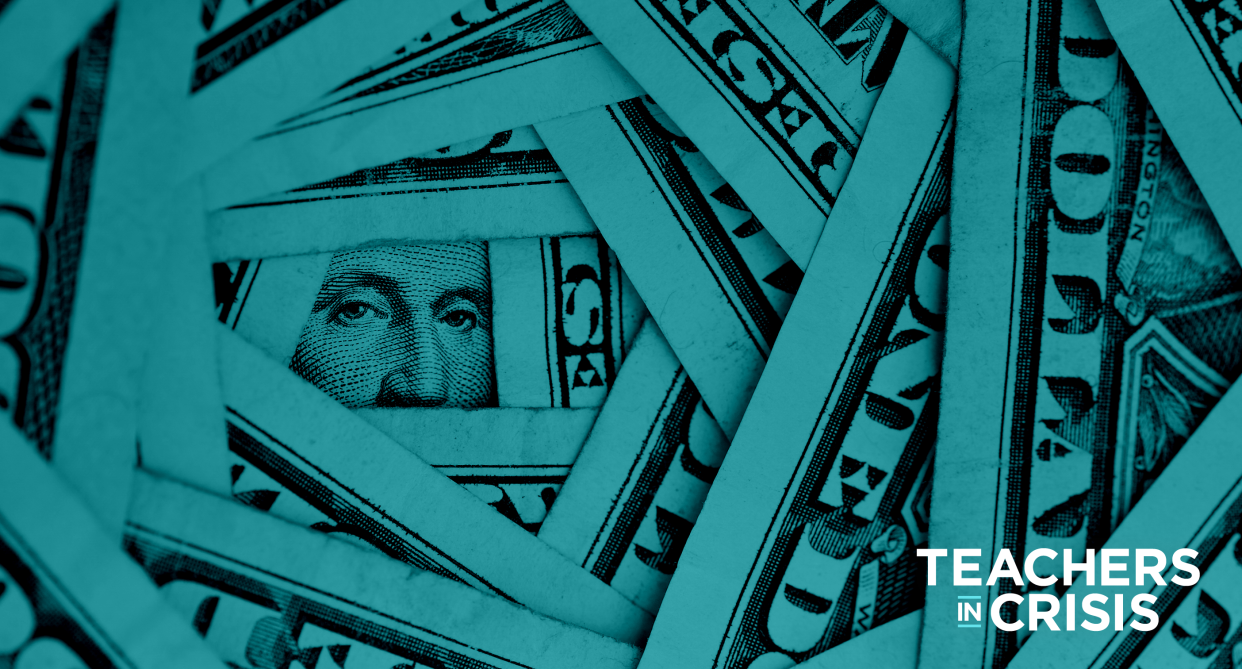'Being a teacher doesn't pay the bills': Here's the starting salary of educators in each state

Through hearing stories from more than 50 former public school educators, shared exclusively with Yahoo Lifestyle for our back-to-school Teachers in Crisis series, one thing became abundantly clear: No one goes into teaching to get rich.
“I walk dogs and I literally make the same amount of money,” says a former North Carolina math teacher. Added another from Tennessee, “I drove a 1996 van ... because I couldn't afford anything else.”
Of course, teaching has never been an especially lucrative job. In her 2014 book The Teacher Wars: A History of America’s Most Embattled Profession, Dana Goldstein argues that this is inextricably linked to the “feminization” of the profession in the early 1800s — when women were recruited to education in droves and taught to view it “less as a career than a philanthropic vocation or romantic calling.” In an 1842 manual for schools in New York, in fact, one education reformist wrote that women were the “cornerstone of a ‘cheap system,’” since “the most talented women would be willing to work for half of what men of the ‘poorest capacity’” would demand.
Goldstein argues that the effect of this early “rose-tinged conception of women teachers’ virtue” still persists today, and is a major reason why states continue to drastically underpay public school teachers nationwide, 76 percent of whom are women.
Still, while teachers’ salaries are inarguably a longstanding problem, many experts say they’re somehow getting worse.
In a 2016 study by the Economic Policy Institute (EPI), the organization notes an “erosion” in teacher salaries that’s been happening for decades. In the 1960s, the report says, teachers earned more than similarly educated workers, but, by the 1980s, this trend had reversed. The result is what’s known as the “teacher penalty,” defined by experts at the University of California, Berkeley, as “the percent by which public school teachers are paid less than comparable workers.”
Between 2010 and 2018, the EPI found this “teacher penalty” to grow from 13.5 percent to 21.4, meaning teachers now make more than 20 percent less than similarly educated professionals. Fueling this problem is the fact that teachers’ salaries, when adjusted for inflation, have actually decreased over time, from $1,216 per week in 1996 to $1,195 in 2018. During this same time frame, weekly wages have actually risen $323 for other college graduates, from $1,454 in 1996 to $1,777 in 2018.
The low salaries not only affect current teachers but the number of those choosing to enter the profession. Nowhere is that more apparent than in starting teachers’ salaries nationwide, which have dropped 4.5 percent over the past decade, according to the National Education Association (NEA). This problem is more pronounced in certain regions, including the Midwest and the South, both of which have average starting salaries that fall below the nationwide average of $39,249.
In NEA’s ranking, the state with the lowest average starting salary is Montana ($31,418), followed by Oklahoma ($32,010), Missouri ($32,226), South Carolina ($33,148) and West Virginia ($33,323). The District of Columbia comes in with the highest starting salary ($55,209), followed by New Jersey ($51,443), California ($46,992), Alaska ($46,954) and Hawaii ($46,790). Overall, the report found that 63 percent of public school districts still offer a starting salary below $40,000.
“How can we recruit and retain quality teachers for our students if we don’t pay them what they’re worth?” NEA president Lily Eskelsen García said after the release of the report. “It is time to show respect to those professionals who dedicate their lives to students and building the future of our communities. Professional work deserves professional pay.”

The good news, as García notes in an interview with Yahoo Lifestyle, is that 2018 seemed to be the year teachers in America — fed up with budget cuts, dwindling salaries and lack of administrative support — began taking to the streets to change things.
“For too long, noneducator politicians have been ignoring the voices of educators who dedicate their lives to kids in communities across the nation,” García tells Yahoo Lifestyle. “Over the past two years, thousands of educators have stood up to say, ‘Enough!’”
The teacher strikes, which began in West Virginia and rippled out to Oklahoma, Arizona and Colorado, have galvanized under the slogan #RedforEd, which encourages all those striking to wear red in solidarity with educators. The movement, as one NEA strategist put it, is a “living breathing thing” that is helping enact real change. In Arizona, one of the most successful states, months of strikes and marches led Gov. Doug Ducey to pass a plan to raise teachers’ salaries 20 percent by 2020, beginning with a nearly 10 percent hike this year. More strikes are on the horizon. Close to 35,000 teachers in Chicago announced this week that they plan to walk out on Oct. 17 if their request for a salary increase is denied.
Teachers, says García, “are demanding respect for our educators and their profession. This movement has delivered real wins to strengthen our public schools from West Virginia and Alabama to Oregon, Illinois and California. And the momentum keeps on growing.” For the teachers themselves, the hope is that increased awareness will continue to lead change.
But for now, the frustration is real. “Being a teacher doesn't pay the bills,” says Rachel Bardes, a 16-year veteran of teaching who left this year, in part to spend time fighting for better treatment. “It is disgraceful. ... [And] it hasn’t gotten better. It’s actually gotten worse.”
If you’re a teacher who wants to share your story, send an email to [email protected]
Read more from Yahoo Lifestyle:
'Things have just gotten so bad': Why teachers in America are leaving the classroom for good
Teachers are turning to 'sugar daddy' dating site to supplement their salary
Follow us on Instagram, Facebook and Twitter for nonstop inspiration delivered fresh to your feed, every day.

